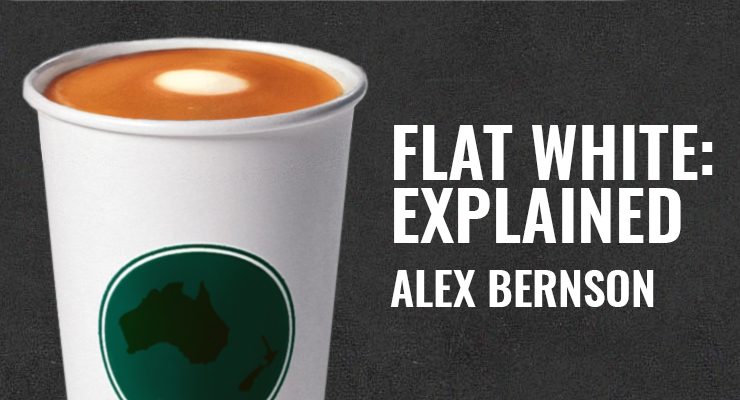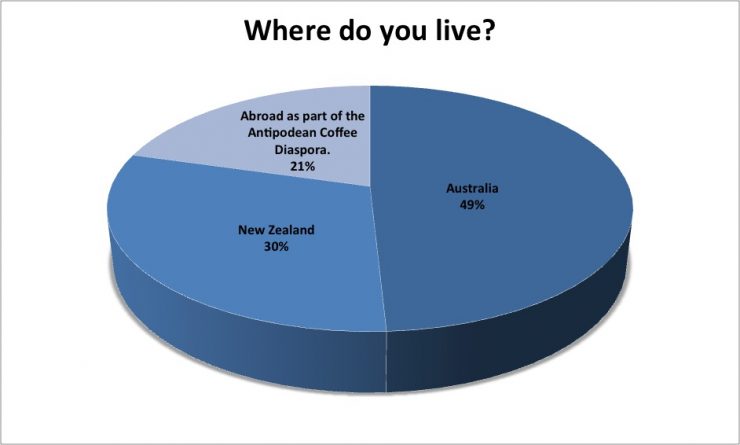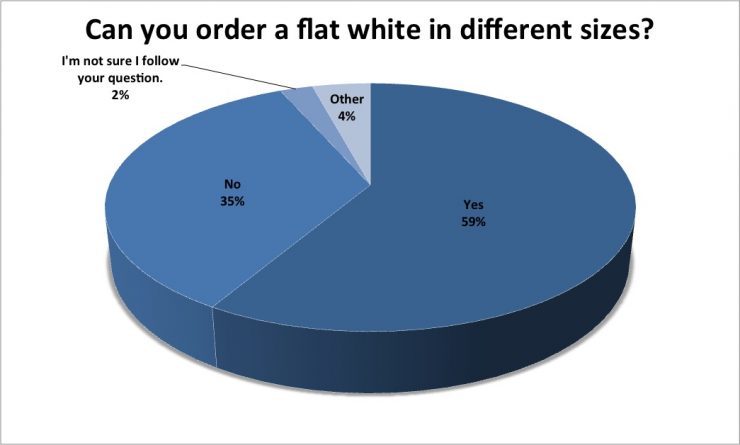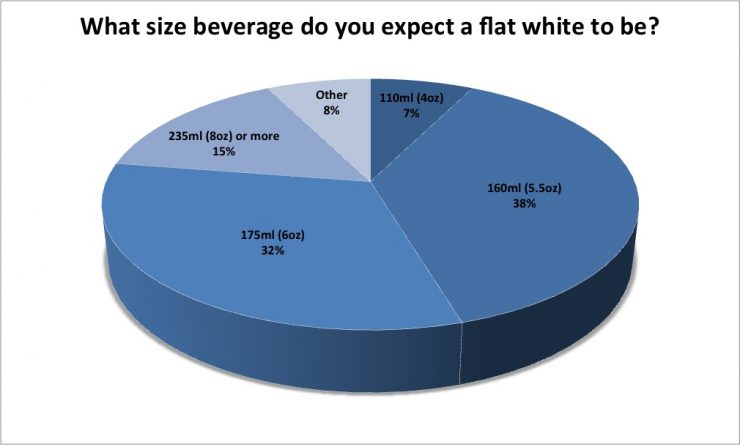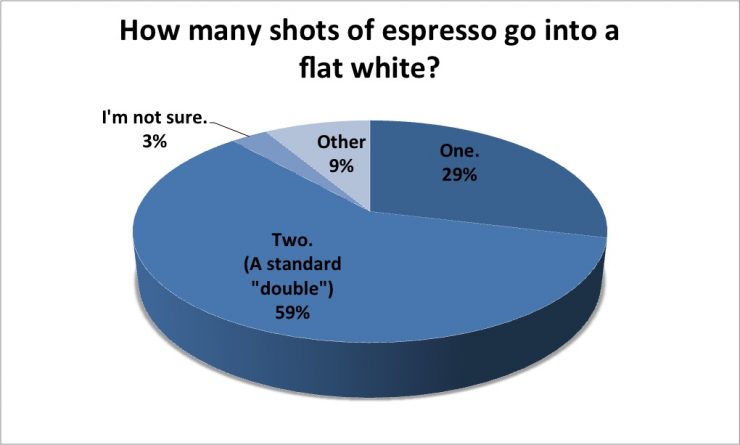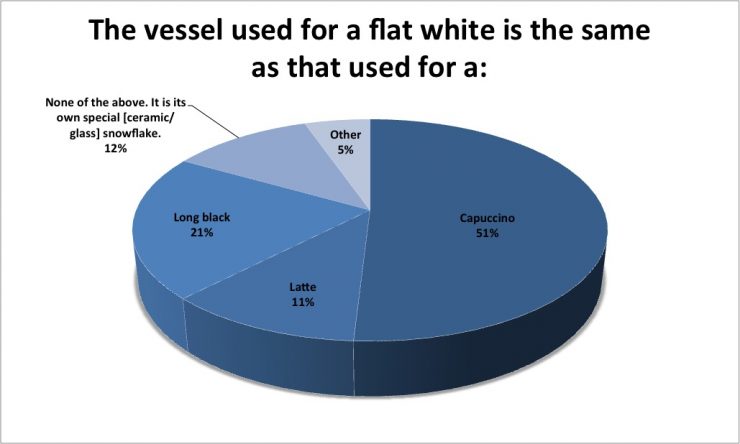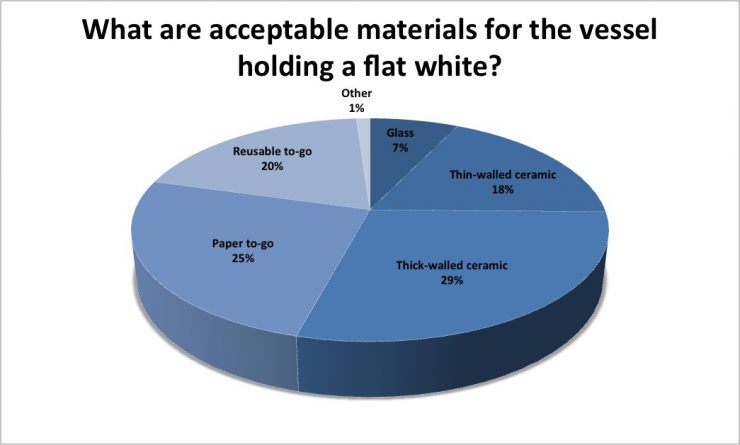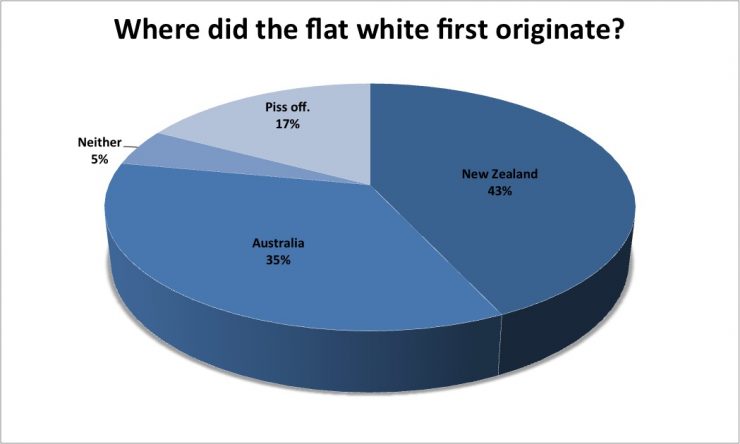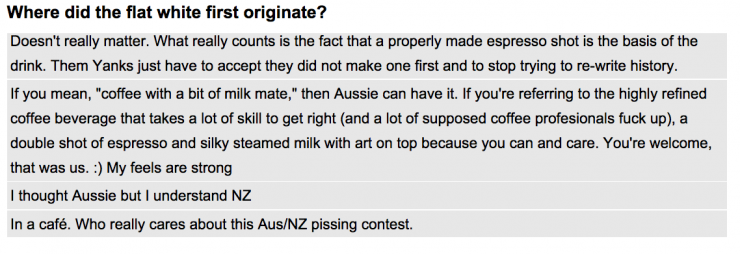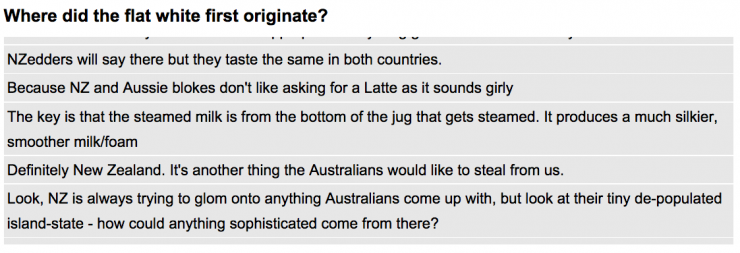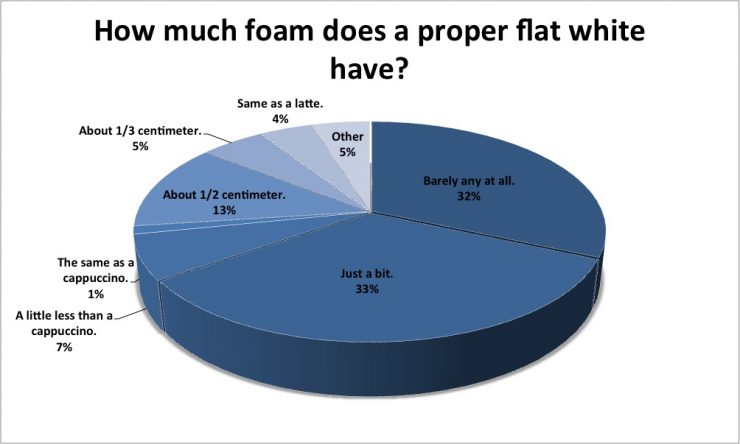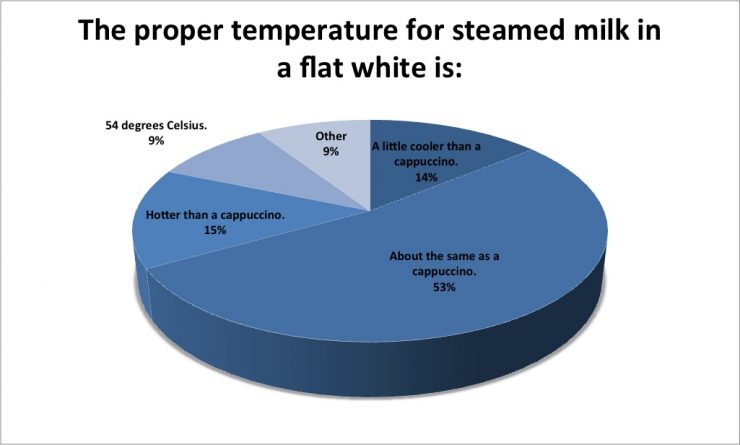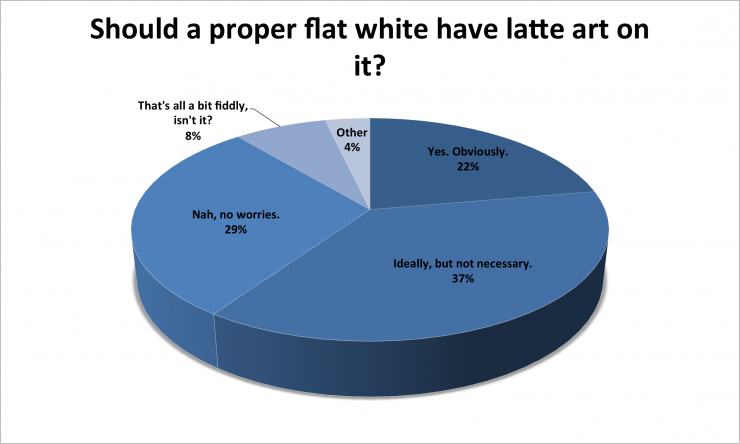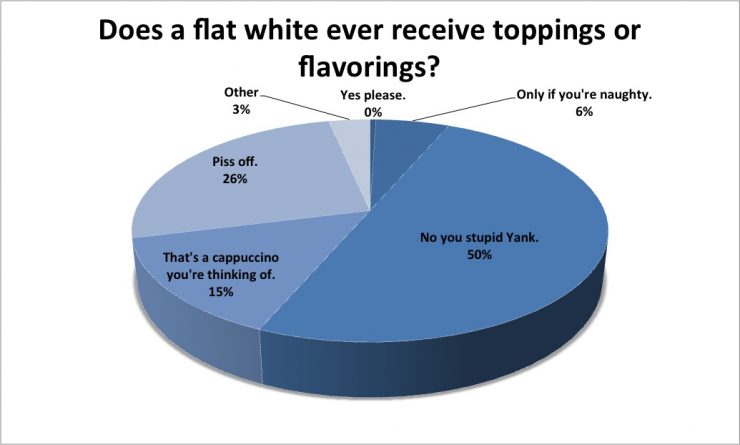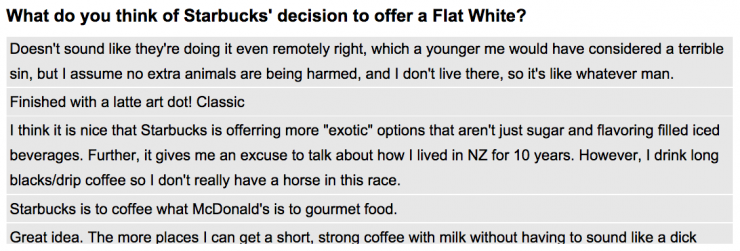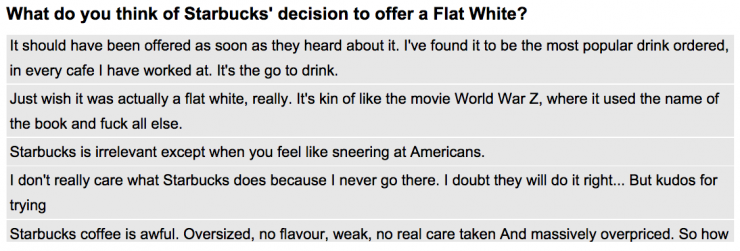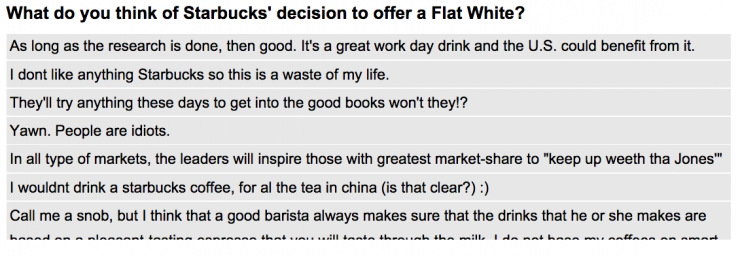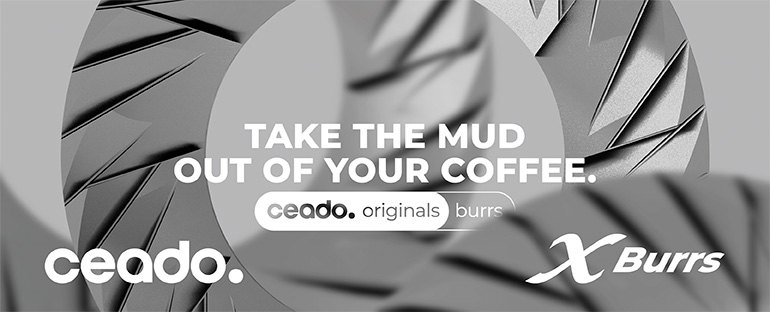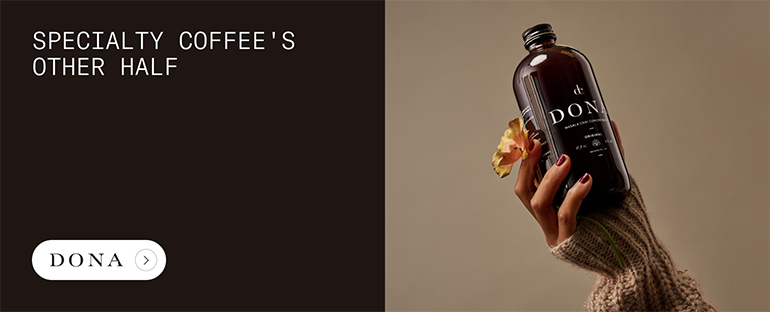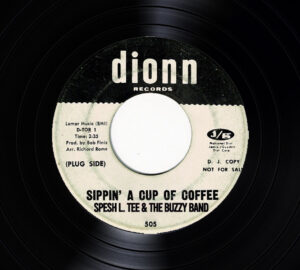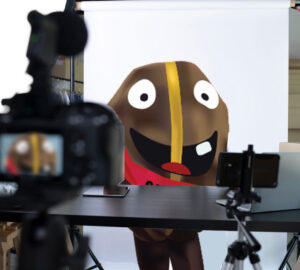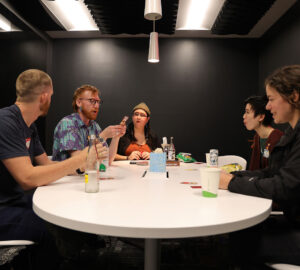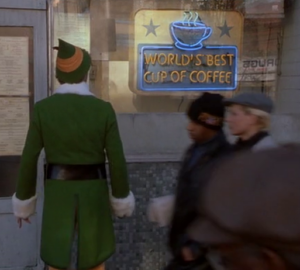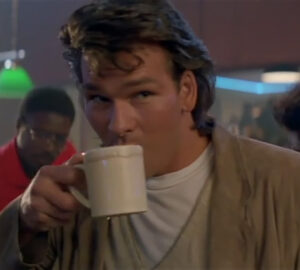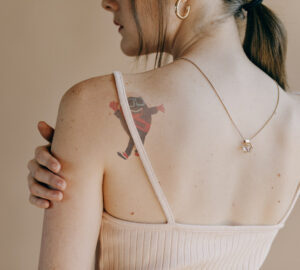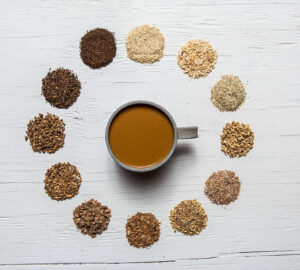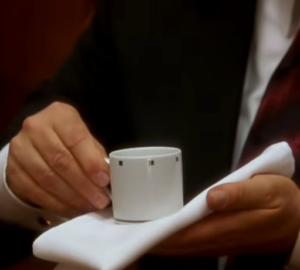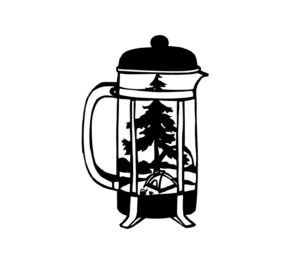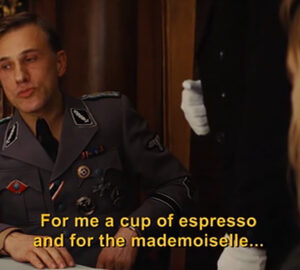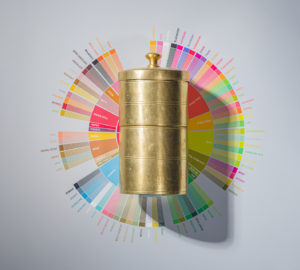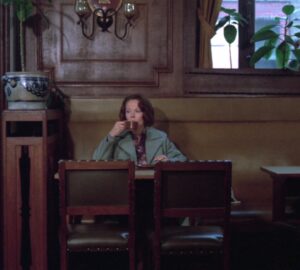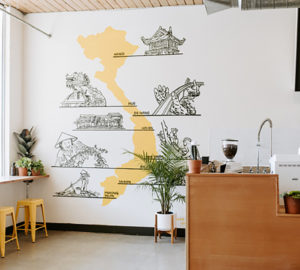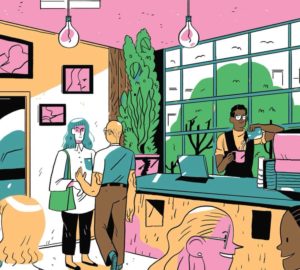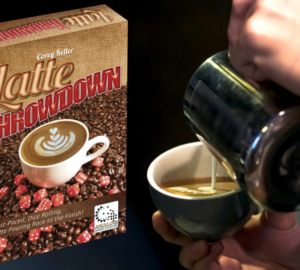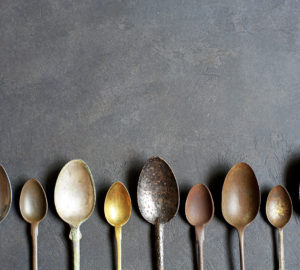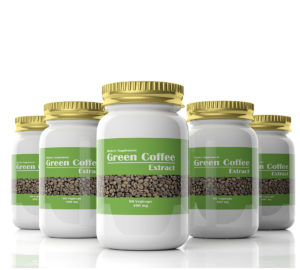The flat white. A storied, semi-mythical beverage that has been the object of hushed adulation and media hot takes for years. It’s a combination of milk and espresso that originated from somewhere Antipodean and has been happily consumed in Australia and New Zealand without (too much) fuss for quite a while now. Predicting the flat white’s moment in North America has become something of a perennial pastime, but finally, the time has come. The flat white is suddenly hip, the order on everyone’s lips in the United States. This may have something to do with Starbucks recently launching its own Starbucks® Flat White espresso and milk beverage here, after five years of selling them in the UK and Australia.
The first thing you need to know about the flat white is that it contains multitudes. Like much of post-industrial consumer culture, the flat white is a symbolic proxy through which we express our hopes, fears, and anxieties, and in its exchange, try to placate the ravenous calling for social distinction and connection. It gives people feelings. The flat white is the latest fancy coffee battleground through which our trans-national tastes in coffee, identity, and late capitalism are simultaneously represented, contested, and inverted.
Before we can actually start interrogating Starbucks® flat whiteness in detail though, what we really need is a simple explainer of just what the original flat white actually is. To that end, Sprudge conducted a very serious poll that definitively settled for all time what exactly a proper Antipodean Flat White is. We asked Starbucks’ Global Brand Communications representative Haley Drage a boatload of questions about the Starbucks® Flat White. We talked to leading experts in the fields of coffee, the Antipodes, and Anthropology to understand the wider symbolic context of the flat white as a beverage. And now, after much painstaking and rigorous research, data, and #journalism, we’re finally ready to explain the brews.
This is it, people: the definitive flat white explainer. Hold on to your butts.
Okay, tell me about this flat white poll.
We heard all the fuss, so we asked our Antipodean readers to weigh in. And weigh in they did, 2365 Aussies and Kiwis to be exact. First we made extra sure they were real Antipodeans, and thus qualified to weigh in on flat whiteness:
As expected, Australia has a strong and vocal showing, though New Zealand is not to be missed, and the Antipodean Coffee Diaspora (ACD) is a very real thing, peddling fine toasts and espressos (short blacks) from New York to Berlin.
I’ve heard size is important for flat whites. Is this true?
Oh my is it important! So important that no one can agree on what size exactly an Antipodean Flat White is supposed to be.
First off, many people claim the flat white is a defined-size drink, like the classic one third milk, one third foam, one third espresso cappuccino, or the Gibraltar and its specific glass. But that doesn’t seem wholly true!
Now, confusion is normal when it comes to ordering coffee drinks, so maybe we can chalk up this contentious split decision to drink-term creep, the same sort of linguistic variance that that has people ordering a “large cappuccino” all over America. But in North America, a 5.5-8oz (162-236ml) drink is generally accepted as a modern cappuccino. There should be some agreement on the standard flat white size, right?
As you can see, Antipodeans generally agree: a flat white is pretty small-ish. If you want to get all technical, calling it a fairly standard ~160ml (5.5oz) size seems good.
A flat white = small-ish. Got it. Now, how many shots go into this thing?”
The data seems to suggest that a proper Antipodean Flat White usually gets made with a “double” shot of espresso—though there was a vocal one-shot contingent, some of whom took advantage of the free-response boxes to suggest that Melbournians and other nefarious Aussies had bastardized the true New Zealand Flat White with their use of single shots.
There were also respondents who noted that our poll failed to understand Aussie & Kiwi ordering practices generally, which rely on the size of the drink ordered and whether a guest orders it “strong” or not.
Still others noted that in the wild world of modern espresso recipes, size and shot differentials remain rather debatable. Some diehards insisted that the defining feature of an Antipodean Flat White is a “double rizz” [ristretto] shot.
There will always be naysayers in any coffee discussion, so let’s just say that a flat white usually gets a double shot. This is a fascinating bit of data on its own, because if true, one could argue the rise of the flat white may have been strongly tied to the doubling of addictive caffeine dosage compared to other drink orders. This data will become especially important once we properly get into our analysis of the Starbucks® Flat White later.
Two shots, mostly. Noted. Do Australians and New Zealanders agree on the cup we’re putting this all in?
Mostly!
So, an Antipodean Flat White goes in a cappuccino cup pretty much, unless you have some fancy flat white goblet at hand. Just like we first heard five years ago.
What that cup made of tho?
Hey! Agreement! No glass.
Cappuccino cup, ideally thick walled ceramic. Dreamy. So where did this neat idea come from anyways?
Funny you should ask!
We would just like to take a moment to remind all of our readers that like any good news site we are ethically required to present all facts in a neutral manner, to take no stance on political issues, and to teach the controversy of both sides of any position.
That all being said, there seems to be some disagreement on where the flat white came from.
Like, actually quite a bit of disagreement…
Bizarre, and at times vitriolic disagreement came rolling in throughout our poll responses, accompanied by many interesting theories. Several responders helpfully pointed out that the “Piss Off” contingent would be entirely Australian; we included the option for whose who were outraged at the very question.
We learned a great deal about several ongoing conspiracy theories involving Australians stealing things from Kiwis, and vice-versa:
The exact origin details of the flat white remain uncertain, with perhaps even arguments for parallel construction. And it appears that the very question itself–“Where did the flat white first originate?–taps into some deep inner part of the Australian and Kiwi psyche, respectively.
But while there are a wide variety of origin claims, a now closed cafe in Auckland called DKD, and its proprietor Derek Townsend, did show up mentioned more than any other specific place. We’ll be following up.
For the moment, let’s just acknowledge the fact that our indisputable, definitive poll found that, by a slight margin, someone in New Zealand probably invented the flat white. We here in the United States are fond of legislating history, so let’s call it: New Zealand invented the flat white. The people have spoken.
Oh my heavens. New Zealand, Australia, and beverage banditry! With all this controversy, I hesitate to even ask about the foam on a flat white. I hear it’s like, really important.
What we do know is that the Antipodean Flat White involves foam.
So apparently, the proper flat white does not have tons of foam. Barely a bit. Just a little more than not any at all. Not as much as a cappuccino for sure. Or, according to Matt Perger, “99.99% of baristas in Australia steam milk for a flat white the same way they would for a latte.”
Foam feels aside, we can definitively say that the flat white should be a pretty cool drink. In terms of temperature, we’re talking like a hair cooler than a cappuccino.
And yes, a flat white should have latte art—though I do have to compliment our Australian and Kiwi responders for being an understanding lot.
So understanding.
What about putting sprinkles or whip cream or tasty treats on your flat white?
To make a poll definitive, you have to ask lots of different kinds of questions. Being poorly versed in flat whiteness led me to inquire about the potential for toppings or flavorings.
We can now happily confirm that no, a flat white does not get toppings, because it’s not a babycino or a fluffy or whatever, and I am indeed a stupid Yank for asking.
How do Antipodeans feel about the Starbucks® Flat White?
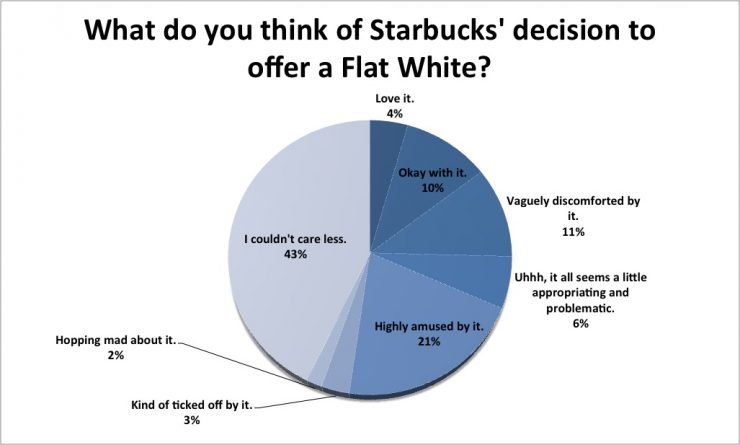
Sounds like a pretty resounding “no worries” on the Starbucks® Flat White front, though the free-response portion of the poll did suggest a wider array of opinion. There were, of course, many rather reasoned and measured reactions:
In addition to a predictable amount of criticism:
Our responders were bemused and cantankerous, yet at the same time capable of wonderfully balanced analysis:
Though I am no anthropologist, I will hazard to say: it seems like Aussies and Kiwis are pretty secure in their flat whiteness, and view the Starbuck® Flat White with, on average, polite disdain.
An Antipodean Flat White is a small-ish drink in a cappuccino cup with two shots of espresso and barely more than a bit of foam. It was also probably invented in New Zealand.
Awesome! We figured out the Antipodean Flat White. Now we just need to understand the technical details of the Starbucks® Flat White, and the sociology of consumer distinction, and we’re good to go!
Oh my god you mean we’re only halfway through this? Let’s take a break. How does this relate to internet cat pictures?
For being such a heated coffee topic, it is surprisingly unrelated to internet cat pictures. Googling “cat latte” is a delight of caffeinated kitties, and “cat cortado” is even pretty great, but “cat flat white” turns up nothing but cats and shoes.
Surely there must be some way that cat pictures can help explain what’s going on here.
No. We must focus.
Fine, tell me about Starbucks® Flat Whites.
You can currently order yourself a Starbucks® Flat White at any participating Starbucks company and licensed stores in the US, and Canada, as well as in Australia and the UK, where they’ve been available for rather a while now. According to Starbucks’ Global Brand Communications representative Haley Drage:
Sounds simple enough, but there’s in fact quite a bit of data to dig into here.
Wait, what’s the deal with these ‘two ristretto shots’
Astute catch, the espresso changes are indeed the most important part of the Starbucks® Flat White! A tall latte at Starbucks has one shot, while a tall Starbucks® Flat White has two shots. Drage even confirmed for us that were guests to order a Grande or Venti Starbucks® Flat White, they would receive a third shot, so this in fact an upping of strength across the board.
In addition, Starbucks has rolled out a new, separate ristretto setting on its super-automatic espresso machines. Drage described this ristretto shot as “a smaller, more concentrated serving of espresso. Rich in sweetness and flavor, a ristretto shot has more body than a regular shot of espresso.” These ristretto shots can be ordered in any Starbucks drink.
What’s more, in the Pacific Northwest, Northern California and Chicago, guests also have the option of ordering a Single Origin Espresso in their Starbucks® Flat White (or any other Starbucks drink). The Single Origin Espresso option is currently Guatemala Casi Cielo, and Drage says that Starbucks plans to rotate this offering about 4-6 times a year.
If all of these changes sound not wildly noteworthy to you, you’re halfway right: specialty cafes have been offering these things for years! But that’s exactly the point: these espresso changes amount to Starbucks modernizing its espresso menu, bringing their parameters more in-line with the offerings of high-end independent cafes. Double shots have long been the standard in the vast majority of North American specialty cafes, and now Starbucks has a comparably coffee-forward (and comparably caffeinated!) drink profile to offer guests.
Hmmm, more modern espresso you say. What about the milk? That seemed super important to the poll responders.
The milk is indeed also super important. First off, the Starbucks® Flat White defaults to whole milk, instead of Starbucks’ standard 2% milk.
According to Haley Drage, there is also a difference in how this milk is being steamed (emphasis ours):
Once that microfoam has been steamed the milk is free-poured into the Starbucks® Flat White, as opposed to the standard practice of holding back and spooning-on foam as appropriate for other drinks. Again, here’s Haley Drage:
Less thick and rough, more light and smooth on the foam. It’s not quite the Antipodean “just a bit” of foam, but it sounds like the Starbucks® Flat White has smoother, thinner foam, at least in theory. That foam is also made much richer and tastier with the use of whole milk.
They’re even (starting) to do “latte art” with the Starbucks® Flat White!
Hmmm, whole milk microfoam with at least a nod towards latte art. Sounds like Starbucks’ milk parameters are getting more modern too.
Okay, so whole milk that’s at least a bit less foamy. What about the size? Isn’t that the big thing with flat whites?
As we learned earlier, Antipodeans are quite united in their belief that a flat white should be small-ish, and Starbucks seems to share this belief, more or less. Remember up above when Haley Drage told us that the the description of the flat white was for “the short and tall versions of the beverage”? She said it because those are the two sizes that the drink is designed to be in, except that only the 12oz “Tall” version of the Starbucks® Flat White is listed on the menu:
This is because, despite stocking the 8oz “Short” cups, Starbucks does not advertise the availability of this size. So, the Flat White is advertised as the smallest option available at Starbucks (still twice the size of the Antipodean Flat White), but with a secret off-menu order you can get a more “authentic” 8oz Starbucks® Flat White, which is only a bit bigger than an Antipodean Flat White.
With a focus on smaller sizes, we see the Starbucks@ Flat White once again bringing drink parameters more in-line with modern espresso trends.
Huh, so that’s closer to the Antipodean Flat White than the rest of their menu, but still kinda far off. Why did Starbucks choose to call its drink a Starbucks® Flat White?
Drage emphasized that the flat white is the “industry standard” name for what they are offering:
The Flat White is emblematic of Starbucks espresso artistry and craft that our baristas strive to create every day. This beverage puts espresso artistry front and center, showcasing each quality ingredient that goes into the beverage. We have offered the Flat White in our stores in Australia and the UK for the last few years, and there is a growing sophistication among coffee drinkers around the world and in the United States and Canada, making this the perfect beverage for coffee lovers.”
A sensible, maybe even obvious seeming reply, if not 100% accurate vis-a-vis the size. What’s really important here though is that word “sophistication”. The Antipodean Coffee Diaspora has been exploding across global capitals of cool recently, from Berlin, to New York, to Singapore, and as that wave of influence begins to crest, it joins a larger swell of Australian and Kiwi influence in culture, music, fashion, wine, beer, events, tech, and food. Starbucks is banking on the rising perception of Antipodean “sophistication” to help it make big changes to its coffee menu.
Can noted coffee anthropologist Professor Merry ‘Corky’ White help explain why Starbucks might want to encourage ‘sophistication’ in their customers?”
Indeed she can! Professor White is a renowned expert on the anthropology of food and consumption at Boston University, wrote the excellent book Coffee Life In Japan, and is in general very wise on the subject of coffee. She kindly agreed to share her thoughts on flat whiteness. Take it away, Corky:
“Like so many culinary novelties, the flat white (actually a pretty humble sort of brew, made, as Oliver Strand says, of two shots with “silky, tight steamed milk”—a microfoam or textured whole milk) has become the stuff of cultural capital. Having had one, you score. Having had one in London, at Flat White on Berwick Street, for example, you score higher. Having had one in Sydney or Auckland, well, there you win. And yet, what besides Vegemite have you had lately from Down Under? It’s an exotic locale, adding something rare to the experience. Australian coffee people are now seen as leaders, teachers, stars in barista competitions and serious players in sourcing, roasting and brewing.
Starbucks has led us into new experiences before, but not for a while. The attempt to persuade us that their instant coffee wasn’t an “instant coffee” fell flat. But we learned to flaunt points of origin of coffee, to make determinations beyond black or “regular.” We learned roast levels, blends and we learned to pay much more for a cup of joe, the price also adding to our own value.
What IS that cultural capital you gain from these experiences? Obviously, the concept needs to be examined—capital, money in the pocket, is in this case status in the pocket from engaging in a cultural phenomenon that confers that status. You gain cultural capital by imbibing a very rare Scotch whisky, or nibbling the cheese illegally carried through customs, or having viewed a hit play on its opening night. Rarity of the commodity or privilege involved in enjoying it contribute to cultural capital. There are other aspects of the status this cultural capital confers: the experience or commodity must be the object of competitive envy. To gain cultural capital in a food experience, you need to be there early, to be an early adopter—after it becomes available to the masses, you’ll be too late.
Another possible source of value is the “true” nature of the item in question: although anthropologists hesitate to say there is any objective “authenticity” having the “perfect” iteration, the “correct” formula, adds to the status of the imbiber. Finally, there should be some discussion, some quarrel, some argument around the item, in which the participant can engage, thus demonstrating his or her connoisseurship, knowledge, and general superiority based on the capital accrued in the experience.
So with the flat white: its origins are debated, its formula uncodified, its spread still rather limited. Scarcity contributes to the cultural capital you’ve pocketed by drinking one.
When it is spotted in your neighborhood, you can either jump into the fray, or just decline to compete, with a wise semi-smile on your foam-flecked lips.”
Wow.
Alright, thank you Corky, and thank you everyone for making it down here! We’ve almost made it.
Here’s what we know:
- There is a coffee drink called a “flat white” that originated in New Zealand (probably). It contains a double shot of espresso. It is supposed to be about 5.5oz (162ml). It comes in a cappuccino cup, or paper if you must, and is covered with barely a bit less foam than a latte. No other additives are included in the drink. Yes please, your flat white can have latte art, but no worries.
- There is a drink called the Starbucks® Flat White, which the company first introduced in Australia in 2009. It has a double ‘ristretto’ shot, as opposed to a standard single shot. It is advertised as a 12oz (354ml) drink, but with a secret menu order you can get a closer to Antipodean 8oz (236ml) sized drink. You can also get a Venti one with three shots of espresso if you so desire. It comes in a paper cup. It is made with whole milk instead of 2%, which is steamed more gently than other Starbucks drinks, and then free-poured, with a gesture towards latte art. There are no other additives (by default).
- The Starbucks® Flat White gives Starbucks a menu offering roughly equivalent to what brands like Stumptown and Blue Bottle have been serving as a “small latte” since at least 2006.
- In the early 1990s, Starbucks had enormous cultural capital, with its cups signifying a new globalized consumption culture. Somewhere along the way, they largerly lost that cutting-edge perception.
- Cultural capital is an integral and deeply desired part of the culture of consumption, and especially food and drink consumption. An air of exclusivity, sophistication and exoticism greatly contributes to the perception of cultural capital attained via consumption.
- Antipodean culture, especially coffee culture, is increasingly at the forefront of global ideas of sophistication.
- The media cannot stop freaking out about flat whites.
- Starbucks is hoping that all of these feels are going to combine with the veneer of global sophistication to reinvigorate the brand’s perceived cultural capital and help them sell Middle America (and soon Middle China, and everywhere else one imagines) on a “new” more modern espresso approach that is more comparable to independent boutique high-end cafes, and by default twice as caffeinated.
- Starbucks is hoping that there will be all sorts of tedious coffee know-it-alls telling their friends about how they like to “order off menu and get a Short Starbucks® Flat White, since you know, it’s actually more authentic that way.”
- Starbucks is already experimenting with further modernizations to their core menu recipes, like single origin espresso.
Here’s what we don’t know:
- Why the Aussies and Kiwis are so invested in their blood feud over who created this specific variation on espresso and milk. Canadians and Americans may disagree on a lot, but we don’t have like, product feuds. What’s the deal?
- Whether or not any of this tastes good.
- What is a flat white, really.
- The degree to which this sudden surge in flat whiteness, and the media’s shallow interest in flat whiteness, is driven by the out of control Melbourne-ification of Brooklyn and especially northern Williamsburg, where American mainstream media and brands look for trends.
So you’re telling me that the Antipodean Flat White is mainly a nicely proportioned bit of milk and espresso, and the Starbucks® Flat White is a highly calculated attempt to piggy-back off Antipodean coffee cool, regain some of Starbucks’ lost cultural capital, and surreptitiously move its customers towards a more modern espresso drink profile?
Yes.
That doesn’t seem that interesting or shocking. And other than the glass, is this any different from the cortado I’ve been drinking for years?
No. Let’s never talk about any of this ever again.
Alex Bernson is the Managing Editor at Sprudge.com, and based in Portland, Oregon. Read more Bernson on Sprudge.











